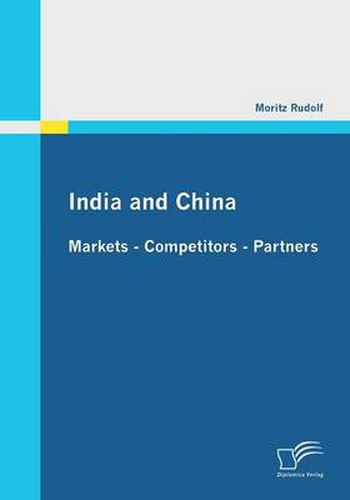Readings Newsletter
Become a Readings Member to make your shopping experience even easier.
Sign in or sign up for free!
You’re not far away from qualifying for FREE standard shipping within Australia
You’ve qualified for FREE standard shipping within Australia
The cart is loading…






This title is printed to order. This book may have been self-published. If so, we cannot guarantee the quality of the content. In the main most books will have gone through the editing process however some may not. We therefore suggest that you be aware of this before ordering this book. If in doubt check either the author or publisher’s details as we are unable to accept any returns unless they are faulty. Please contact us if you have any questions.
Academics, students, the media and the public have been increasingly drawn to China and India in recent years. Both countries were considered sleeping giants and are now turning into the motors of global economic growth. China and India are both ancient civilizations with a rich history and were among the largest economic powers until European colonization in the 19th century. After Indian independence in 1947 and the establishment of the Peoples Republic of China in 1949 both countries shared the view that economic development should be achieved through a self-sustaining economy led and controlled by the government. In the following decades the share of Chinese and Indian global trade decreased significantly. Economic reform in China and India in 1978 and 1991 respectively resulted in an increasing integration into global markets and triggered large economic growth. It is very important to note that although China and India are both rising at the same point of time, they are rising in a different pace. China outperforms India in almost every indicator of economic development. It is the key aim of this study to point out this asymmetry between China and India. Another question is, if India is capable of catching up with China in the future and its effects to Sino-Indian relations. Die Rolle von China und Indien in der Welt hat sich in den letzten Jahren sehr stark gewandelt. Aus Bittstellern wurden Glaubiger und Motoren fur das globale Wirtschaftswachstum. Dieses Buch setzt sich mit den oekonomischen Asymmetrien die zwischen Indien und China existieren auseinander. Ein historischer UEberblick uber die mehr als 2000 Jahre zuruckreichenden oekonomischen Beziehungen ist der Ausgangspunkt der Studie. Beide Volkswirtschaften werden anhand von oekonomischen Indikatoren wie Wirtschaftswachstum, Reduzierung von Armut, Integration in internationale Markte, demographischer Wandel, institutionelle Herausforderungen usw. miteinander verglichen. In einem zweiten Schritt werden d
$9.00 standard shipping within Australia
FREE standard shipping within Australia for orders over $100.00
Express & International shipping calculated at checkout
This title is printed to order. This book may have been self-published. If so, we cannot guarantee the quality of the content. In the main most books will have gone through the editing process however some may not. We therefore suggest that you be aware of this before ordering this book. If in doubt check either the author or publisher’s details as we are unable to accept any returns unless they are faulty. Please contact us if you have any questions.
Academics, students, the media and the public have been increasingly drawn to China and India in recent years. Both countries were considered sleeping giants and are now turning into the motors of global economic growth. China and India are both ancient civilizations with a rich history and were among the largest economic powers until European colonization in the 19th century. After Indian independence in 1947 and the establishment of the Peoples Republic of China in 1949 both countries shared the view that economic development should be achieved through a self-sustaining economy led and controlled by the government. In the following decades the share of Chinese and Indian global trade decreased significantly. Economic reform in China and India in 1978 and 1991 respectively resulted in an increasing integration into global markets and triggered large economic growth. It is very important to note that although China and India are both rising at the same point of time, they are rising in a different pace. China outperforms India in almost every indicator of economic development. It is the key aim of this study to point out this asymmetry between China and India. Another question is, if India is capable of catching up with China in the future and its effects to Sino-Indian relations. Die Rolle von China und Indien in der Welt hat sich in den letzten Jahren sehr stark gewandelt. Aus Bittstellern wurden Glaubiger und Motoren fur das globale Wirtschaftswachstum. Dieses Buch setzt sich mit den oekonomischen Asymmetrien die zwischen Indien und China existieren auseinander. Ein historischer UEberblick uber die mehr als 2000 Jahre zuruckreichenden oekonomischen Beziehungen ist der Ausgangspunkt der Studie. Beide Volkswirtschaften werden anhand von oekonomischen Indikatoren wie Wirtschaftswachstum, Reduzierung von Armut, Integration in internationale Markte, demographischer Wandel, institutionelle Herausforderungen usw. miteinander verglichen. In einem zweiten Schritt werden d